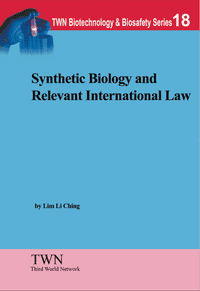TWN Biotechnology & Biosafety Series 18: Synthetic Biology and Relevant International Law
[Synthetic Biology and Relevant International Law]
This booklet describes the multilateral treaties that apply to various aspects of synthetic biology, including the Convention on Biological Diversity and its Cartagena Protocol on Biosafety. The author also addresses potential gaps in the current governance and proposes new principles for a more holistic regulatory approach towards synthetic biology.
SUMMARY
This book in the Third World Network’s (TWN’s) Biotechnology and Biosafety Series explores international treaties with applications to synthetic biology. The book is divided into three chapters. The first discusses the relevance of the Convention on Biological Diversity (CBD) and the associated Cartagena Protocol on Biosafety (CPB) to synthetic biology. The second chapter focused on other international laws and agreements that may apply to synthetic biology, including the Biological Weapons Convention and the WTO Agreement on the Application of Sanitary and Phytosanitary Measures (SPS Agreement). The second chapter also addresses gaps in the existing frameworks. In light of these gaps, the author proposes several principles and objectives for the regulation of synthetic biology.
TWN is an international non-profit that focuses on issues relating to global development and North-South affairs. It was formed in 1984 to strengthen cooperation between development and environment groups in the global South. To encourage equitable and ecologically sustainable development in the global South, TWN conducts research, publishes books, and hosts conferences and workshops. Other publications in the TWN Biotechnology and Biosafety series focus on genetic engineering and other emerging biotechnologies. While No. 16 and No. 15 in the series are available in Spanish, this document is currently only available in English. It is the last publication in the series, and no further updates are expected. This book may be useful to regulators attempting to understand current international frameworks governing synthetic biology.


..png)
